Trevor B. Persons, Louis R. Bevier, and Tom Aversa
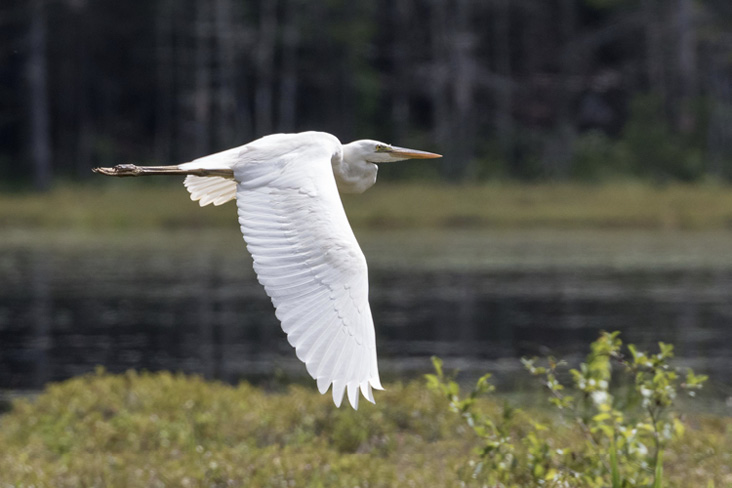
This Great White Heron was at Stoneham June 28–August 1, 2017. Photograph July 8, 2017, by Louis Bevier.
The Tenth Report of the Maine Bird Records Committee (hereafter ME-BRC or the committee) summarizes 96 reports involving 58 species, including two distinctive subspecies, that were evaluated and decided during 2020. The committee accepted 77 records for an acceptance rate of 80%. Although many reports were recent, the years of occurrences ranged from 1903 to 2020.
No new species were added to the state list, but the committee accepted first state records of two distinctive subspecies: Greenland Dunlin (Calidris alpina arctica) and Great White Heron (Ardea herodias occidentalis). Review and rejection of a 1903 report of Whooper Swan that had been placed provisionally on the state list dropped the total number of documented species on Maine’s state list to 463. However, historical reports of fifteen additional species that had been placed provisionally on the state list were reviewed and accepted. The official list of bird species recorded in Maine, our review procedures, and the list of members can be found at the committee’s website: <http://sites.google.com/site/mainebirdrecordscommittee.>
Records in this report are grouped by species; records accepted and those not accepted are listed within the same species account. Each record provides the location, county (italicized), date(s) of occurrence, names of observers or contributors, and committee record number. Documentation was provided by the observers listed or, in some cases, was obtained from publicly published websites. All reviewed materials and member comments are archived. If known, the names of finders are listed first and separated from other names by a semicolon. Photographic, video, or audio evidence reviewed is denoted by a dagger (†); written notes are denoted by an asterisk (*). As always, the committee strongly encourages written submissions even when there are photographs. Species accounts follow the current taxonomic classification and sequence adopted as of 2020 by the American Ornithological Society (list available at <http://checklist.americanornithology.org/taxa/>).
Species Accounts
Pink-footed Goose (Anser brachyrhynchus). Maine’s eleventh and twelfth accepted records—all since 2009—came from Wiscasset, Lincoln, March 22, 2020 (Loretta Leighton; Rhonda Hamlin†, Doug Hitchcox†; 2020-005) and Somesville, Mount Desert, Hancock, May 27–30, 2020 (Craig Kesselheim†; 2020-012).
Whooper Swan (Cygnus cygnus). NOT ACCEPTED, IDENTIFICATION AND ORIGIN QUESTIONED: A species that had been provisionally on the state list based on a specimen collected at “Mud lake” (Upper or Lower Mud Lake not specified), Alexander, Washington, September 10, 1903 (1903-001) was removed from the list. It was first reported by Swain (1904); a photograph of the mounted specimen appeared as the frontispiece in The Journal of the Maine Ornithological Society volume 8, number 1, March 1906, and was reprinted (with the wrong date) in Knight (1908). The specimen’s whereabouts is unknown (Palmer 1949). Clark (1905) identified it based on “the yellow covering of the lores and extending over the larger portion of the upper mandible” but this is imprecise as to extent of yellow and impossible to discern, or is not apparent, in the black and white photograph. Reported measurements of wing length, wingspan, and overall length (Swain 1904, Clark 1905) are far shorter than reported ranges for Whooper Swan, including a supposed smaller and extirpated Greenland-breeding population (Cramp and Simmons 1977). Wingspan and overall length fit Tundra Swan (C. columbianus), but the reported wing length is short for that species (Palmer 1976). The committee also questioned the bird’s wild origin, citing September 10 as early for a fall migrant Whooper Swan at this latitude and noting that waterfowl collections were already present in North America and a potential source (McEneaney 2004). Thus, even if the identification could be confirmed, provenance of the bird is suspect, as is also true of Maine’s five more recent records (Sheehan 2020).
Tufted Duck (Aythya fuligula). This was first reported in Ellison and Martin (2000), and recollections of field marks by one of the original observers—W. Townsend—led the committee to accept an otherwise sparse report of a bird seen by multiple observers at Bar Harbor, Hancock, November 14 to December 5, 1999 (W. Townsend, B. Barker, J. Markowsky; 1999-003). NOT ACCEPTED, IDENTIFICATION QUESTIONED: Although distant video of an Aythya duck at Hadley Point, Bar Harbor, Hancock, October 22, 2020 (2020-043) appeared consistent with Tufted Duck, the poor images left some members concerned that an Aythya hybrid could not be eliminated.
Willow Ptarmigan (Lagopus lagopus). The species was provisionally on the state list based on at least five credible reports. This year the committee formally reviewed and accepted two birds. One captured in Brooks, Waldo, (date not given) died “two weeks later in mid-May” 1990, at a wildlife rehabilitator’s facility (Frank Hoffman; 1990-002). This bird was reported by Applegate (1996) as an adult male, but the specimen was identified as female by the preparator, Skip Basso, and is now at the Maine State Museum. Another accepted bird was at Great Chebeague Island, Cumberland, May 16 to June 3, 2000 (Darya and Beverly Johnson†; 2000-001). Both showed some prealternate molt, the one staying until June more extensively so.
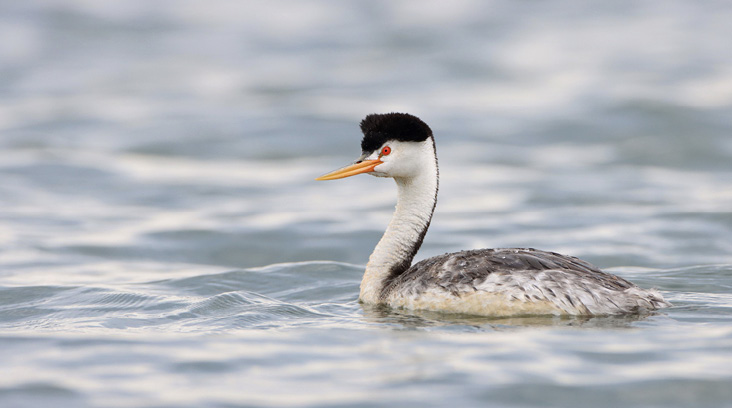
New England’s second Clark’s Grebe was approachable by kayak during its stay on Togus Pond, Augusta, August 8–15, 2020. Photograph August 9, 2020, by Luke Seitz.
Clark’s Grebe (Aechmophorus clarkii). The second record for Maine and New England visited Togus Pond, Augusta, Kennebec, August 8–15, 2020 (Tom Renckens†, Sarah Fagg; Doug Hitchcox†, Logan Parker†, Luke Seitz†; 2020-026). The recorded advertising call was consistent with A. clarkii (recording, D. Hitchcox) and delivered as a single, grating creet. Sex based on bill shape, often possible, was indeterminate.
Band-tailed Pigeon (Patagioenas fasciata). Two of three older records were reviewed and accepted: Southport Island, Lincoln, April 25, 1980 (Peter Vickery†; 1980-002) and Monhegan Island, Lincoln, September 25, 1994 (Peter Vickery*; 1994-004), originally published in Vickery (1980) and Ellison and Martin (1995), respectively. One additional report from Monhegan in 1990 has yet to be reviewed.
Eurasian Collared-Dove (Streptopelia decaocto). Maine’s third accepted record was photographed and heard calling at Pemaquid Point, Lincoln, May 14, 2020 (Zeke Smith†*; Sean Hatch†; 2020-008). NOT ACCEPTED, IDENTIFICATION QUESTIONED: Photographs of a Streptopelia dove in Portland, Cumberland, August 15, 2020 showed pale primaries, suggesting an escaped African Collared-Dove (S. roseogrisea), and most members thought details were insufficient to identify the bird (2020-036).
Chuck-will’s-widow (Antrostomus carolinensis). Presumably the same singing bird from 2018 returned to Orland, Hancock, June 4 to July 16, 2019 (Tom Bjorkman, Fred Yost, Leda Beth Gray; Kyle Jones†; 2019-026) and again June 27 to July 25, 2020 (Rich MacDonald†; 2020-023). Unlike in 2018, a second bird was not reported in 2019 or 2020, although territorial behavior suggests that a pair may have nested each year. The committee also accepted a previously reported (Finch 1975) sight record from Bar Harbor, Hancock, May 24, 1974 (Will Russell*; 1974-001).
Rufous Hummingbird (Selasphorus rufus). An immature male was at Yarmouth, Cumberland, October 18 to December 5, 2020 (Randy and Nancy Billmeier†; Louis Bevier†, Josh Fecteau†, Jeanette Lovitch†, Luke Seitz†, Don Thompson†, Marian Zimmerman†; 2020-044).
Clapper Rail (Rallus crepitans). One was at Scarborough Marsh, Cumberland, September 20 to October 6, 2015 (Logan Smith†; Louis Bevier†; 2015-018).
King Rail (Rallus elegans). A pair first documented in 2016 at Webhannet Marsh, York (Bevier 2017) returned April 26 to September 28, 2017 (Andrew Aldrich†; Margaret Viens†; 2017-009) and May 7 to September 13, 2018 (Andrew Aldrich†; Bri Benvenuti†, Tracy Rousseau†; 2018-046) with nesting confirmed in 2018. NOT ACCEPTED, IDENTIFICATION QUESTIONED: Reports of heard-only birds at the same location May 4–17, 2019 (2019-012) were not confirmed and lacked convincing evidence.
Wilson’s Plover (Charadrius wilsonia). One visited Popham Beach State Park, Sagadahoc, June 9, 2020 (Laura Zitske; Noah Gibb†*; 2020-019).
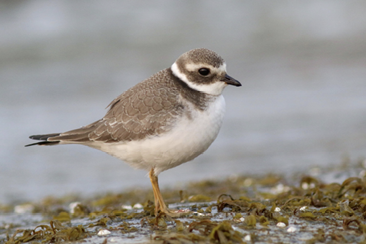
Maine’s second Common Ringed Plover, a juvenile, was at Seal Island National Wildlife Refuge September 15–19, 2020. Photograph September 15, 2020, by Keenan Yakola.
Common Ringed Plover (Charadrius hiaticula). This species was previously unreviewed; the state’s first was an adult male at Lubec, Washington, August 26 to September 3, 2003 (Louis Bevier*†, Don Mairs, Ron Joseph; Denny Abbot†, Peter Vickery*; 2003-007). Although it was published as staying through September 5 (Ellison and Martin 2004), the last convincing description accepted is from September 3. Maine’s second, a juvenile, was photographed and its voice recorded at Seal Island National Wildlife Refuge, Knox, September 15–19, 2020 (Keenan Yakola*†; Coco Faber†, Mikayla Ockels; 2020-029).
Bar-tailed Godwit (Limosa lapponica). NOT ACCEPTED, IDENTIFICATION QUESTIONED: Petit Manan National Wildlife Refuge, Hancock, November 21, 1987 (1987-002). Although the original description (Maine Bird Notes volume 1, number 3, Autumn 1987) by the lone observer fairly well described a Bar-tailed Godwit of the nominate European subspecies, some members thought that it was not sufficient for first state record acceptance. In addition, the dismissal of the report by Vickery (2020) as a possible misidentification raised questions about the veracity of the report. The species remains provisionally on the state list based on two earlier reports awaiting review and potential location of photographs.
Ruff (Calidris pugnax). Well-documented adult males were at Scarborough Marsh, Cumberland, July 3, 2011 (Doug Hitchcox†, Mathias Deming; 2011-019), Penjajowac Marsh, Bangor, Penobscot, May 13, 2014 (Brian Rolek†; 2014-018), and Weskeag Marsh, South Thomaston, Knox, May 19–20, 2016 (Don Reimer; Louis Bevier*†, Richard Garrigus†, Timothy Thompson†; 2016-037).
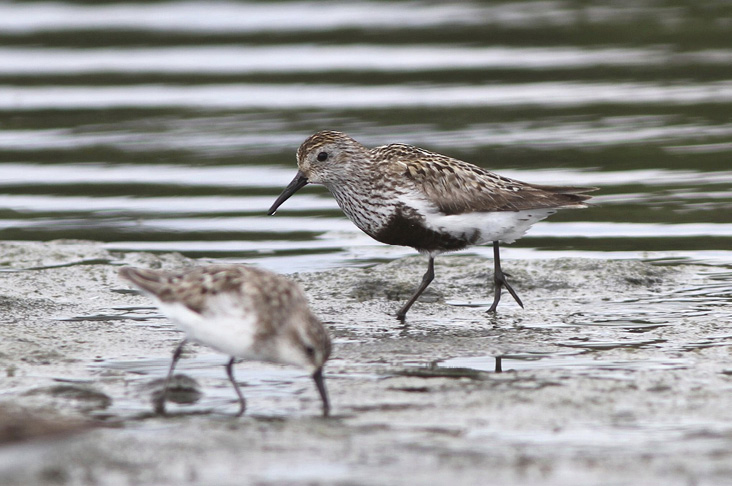
This Greenland Dunlin (Calidris alpina arctica) at Popham Beach State Park August 8–13, 2015 is the first of this taxon accepted for Maine. Photograph August 12, 2015, by Doug Hitchcox
Dunlin (Greenland Dunlin) (Calidris alpina arctica). Popham Beach State Park, Sagadahoc, August 8–13, 2015 (Mike Fahay*†, Bruce Pickholtz†, Doug Suitor*; Doug Hitchcox†; 2015-011). Although two birds were reported, examination of photographs submitted by Pickholtz proved only one bird was involved based on matching details of plumage. This is the first report for Maine of this small, short-billed subspecies, and one of only a handful documented in North America. Unlike the expected subspecies C. a. hudsonia, adults of which molt into basic plumage prior to southward migration, C. a. arctica and affiliated European subspecies molt after arrival on the wintering grounds. An earlier report from Popham Beach on July 21, 2013, not submitted to the committee , may also represent C. a. arctica; the single photograph shows an alternate-plumaged individual that appears to lack rufous upperparts, but the bill is not visible.
Of the few North American records of C. a. arctica, two are from Massachusetts: one collected at Monomoy, August 11, 1900 (Griscom 1937) and one photographed at Chatham, July 29, 2007 (Iliff and Garvey 2010). Griscom and Snyder (1955) listed the 1900 bird as being in the collections of the Boston Museum of Science (BMS 12960). Griscom and Snyder (1955) also noted two additional “small and very short-billed Dunlins” collected at Monomoy, on November 19, 1941 (BMS 18928) and August 4, 1946 (no catalog number given) that they considered to possibly represent C. a. arctica. The whereabouts of these specimens is unknown. Many biological specimens in the BMS were apparently transferred to Harvard’s Museum of Comparative Zoology (Johnson 2004), but that collection’s online catalog does not include any of these Dunlins.
Long-tailed Jaeger (Stercorarius longicaudus). An adult was photographed off Monhegan Island, Lincoln, May 29, 2019 (Jennifer Eston†; 2019-050) and a juvenile was inland on Webb Lake, Weld, Franklin, September 10, 2020 (Scott and Kyle Isherwood†; 2020-028).
Ivory Gull (Pagophila eburnea). Although there are over a dozen specimens or reports dating back to 1880, the first reviewed by the committee was a well-documented immature from Portland, Cumberland, January 25 to March 13, 1997 (Lysle Brinker; Bob MacDonnell†, Nick Pulcinetta†; 1997-003). NOT ACCEPTED, IDENTIFICATION QUESTIONED: Description of a bird seen distantly from a moving boat at Monhegan Island, May 14, 1997 (1997-004) was more consistent with Iceland Gull (Larus glaucoides). The date was reported incorrectly as May 13 by Perkins (1997), who suggested it may have been the same bird seen in Portland (1997-003, above).
Sooty Tern (Onychoprion fuscatus). An adult was photographed flying over Matinicus Rock, Knox, August 5, 2020 (Jesse Lewis†; 2020-025) following passage of Hurricane Isaias.
Pacific Loon (Gavia pacifica). Most of the committee thought that although reviewed separately, a juvenile photographed at Pine Point, Scarborough, Cumberland, March 27, 2019 (Stephen Everett†; 2019-003) and April 10–27, 2019 (Ethan Whitaker†; Glenn Hodgkins†, John Heath*; 2019-005) were likely the same individual. NOT ACCEPTED, IDENTIFICATION QUESTIONED: Photographs of a bird off Appledore Island, York, May 25, 2019 (2019-056) were more consistent with Red-throated Loon (Gavia stellata), and descriptions of a loon at Ogunquit, York, March 3–5, 2020 (2020-004) were inadequate to rule out other species.
Band-rumped Storm-Petrel (Hydrobates castro). NOT ACCEPTED, IDENTIFICATION QUESTIONED: Photographs of a well-described bird seen distantly at Long Lake, Sinclair, T17 R4 WELS, Aroostook, September 20, 2020 (2020-033) show a white-rumped Hydrobates storm-petrel with some features suggesting the more likely Leach’s Storm-Petrel (Hydrobates leucorhoa), which the committee agreed could not be eliminated.
Magnificent Frigatebird (Fregata magnificens). NOT ACCEPTED, IDENTIFICATION QUESTIONED: Cell phone photographs of a bird seen briefly over Great Moose Lake, Hartland, Somerset, September 17, 2020 (2020-031) clearly showed a frigatebird, but species other than Magnificent could not be eliminated.
Brown Booby (Sula leucogaster). NOT ACCEPTED, IDENTIFICATION QUESTIONED: Although the description of a bird seen off Seal Island National Wildlife Refuge, Knox, August 5, 2018 (2018-047) was consistent with an adult Brown Booby, most members thought the report was too sparse to completely eliminate other species.
American White Pelican (Pelecanus erythrorhynchos). This species was removed from the review list in 2014. However, the committee accepted two earlier records: Saint Agatha, Easton, and Fort Fairfield, Aroostook, July 10 to September 3, 2013 (David Milligan and Claire Michaud; Louis Bevier†, Doug Hitchcox†, Bill Sheehan†, Rob Speirs†; 2013-025) and St. George, Knox, September 8–14, 2013 (Don Reimer; Margaret Viens†, John Wyatt†; 2013-026). Due to an injury on the Aroostook County bird’s bill, it was identified as the same individual seen at multiple locations in Massachusetts, New Brunswick, Nova Scotia, and Quebec during the summer of 2013.
Brown Pelican (Pelecanus occidentalis). One was photographed flying by Biddeford Pool, York, June 8, 2020 (Brad Woodward†; 2020-018).
Great Blue Heron (Great White Heron) (Ardea herodias occidentalis). One spent over a month at an inland freshwater pond in Stoneham, Oxford, June 28 to August 1, 2017 (Jeannette Ross†; Louis Bevier*†; 2017-051). Although a few committee members initially expressed concern over how one would differentiate a supposed white morph Great Blue Heron from a vagrant Great White Heron, the Stoneham bird showed no characters suggesting a pigment abnormality (leucism) and otherwise matched characters of Great White Heron. Evidence for the existence of a white morph among Great Blue Herons is lacking (Mitra and Fritz 2002, McGuire et al. 2019), but leucistic Great Blue Herons do occur and are obviously abnormally pigmented individuals. Genetic studies demonstrate Great White Heron (A. h. occidentalis) is a valid taxon that mates assortatively and shows differential habitat use from Great Blue Heron where the breeding ranges meet in Florida Bay (McGuire et al. 2019). The timing and location of the Stoneham bird fit a well-established pattern of vagrancy in Great White Heron in the East (Mitra and Fritz 2002).
Little Egret (Egretta garzetta). After Maine’s first records for Little Egret from Scarborough Marsh in 2011–2012, none was reported in 2013–2014, but one or more have been present each year since 2015. The committee accepted reports from Gilsland Farm, Falmouth, Cumberland, of single birds June 8 to July 20, 2015 (Doug Hitchcox*†; 2015-017), April 23 to July 30, 2016 (Richard Garrigus†; Ian Carlson†, Laura Keene†; 2016-017), July 11–September 16, 2017 (Bill Bunn†; Timothy Fennell†; 2017-021), and May 31 to August 27, 2018 (Doug Hitchcox†; Alex Lamoreaux†; 2018-034). At the same location on April 27–28, 2019 (Doug Hitchcox*†; 2019-008) one egret might have been the same bird photographed at Parker River National Wildlife Refuge, Newburyport, Massachusetts, on April 25, 2019 (eBird reports); another bird was present May 1–2 and 25, 2019 (Earl Wilcher†; Doug Hitchcox†; 2019-009). Records from Scarborough Marsh, Cumberland, May 31 to August 27, 2018 (Richard Garrigus; Timothy Fennell†, Margaret Stewman†; 2018-033) and May 30 to September 16, 2019 (Timothy Fennell†; 2019-023) were likely the same individual(s) observed in Falmouth in 2018 and 2019. Likewise, a bird at Biddeford Pool, York, August 2 to September 28, 2016 (Gordon Smith; Dave Cowan†, Rob O’Connell†, Marjorie Watson†; 2016-038) was likely the same individual observed earlier in the year at Falmouth. NOT ACCEPTED, IDENTIFICATION QUESTIONED: Although one bird was accepted from Falmouth in 2018 (2018-034, above), a second bird photographed with it on June 9, 2018, was suspected of being a hybrid with Snowy Egret (Egretta thula). Although one or more birds returned in 2020, review has been complicated by the presence of apparent hybrids possibly extending back before 2018. Suspected hybridization between Little and Snowy egrets in Maine will make determination of species identity increasingly difficult. Little Egret is also suspected to have backcrossed with Snowy Egret x Tricolored Heron hybrids in Maine.
Swallow-tailed Kite (Elanoides forficatus). NOT ACCEPTED, IDENTIFICATION QUESTIONED: Although the committee agreed that the report of a bird seen in Brunswick, Cumberland, May 8, 2020 (2020-021) most likely pertained to this species, the description was too vague for acceptance.
Mississippi Kite (Ictinia mississippiensis). NOT ACCEPTED, IDENTIFICATION QUESTIONED: Inconsistencies in the description led the committee to question whether a bird seen at Kennebunk, York, October 2, 2019 (2019-044) was irrefutably this species.
Barn Owl (Tyto alba). Although provisionally placed on the state list based on more than a dozen reports over the past century, the species had not been reviewed previously. Two reports were accepted: a road-killed specimen, now at College of the Atlantic (COA #1052), from Belfast, Waldo, May 9, 1996 (Ron Joseph†; 1996-003) and one photographed in a barn in Albion, Kennebec, August 9, 2004 (Mike Scholz†; 2004-002). NOT ACCEPTED, IDENTIFICATION QUESTIONED: A report based on recollections of a bird seen for two days in a wooded residential yard in Standish, Cumberland, midsummer 1981 (1981-002) did not eliminate the possibility of other species.
Eastern Screech-Owl (Megascops asio). NOT ACCEPTED, IDENTIFICATION QUESTIONED: Description of a call heard at Freedom, Waldo, March 17, 2003 (2003-006) was not sufficient to rule out other species. The committee no longer reviews reports from southern Maine (York County), where the species presumably breeds in small numbers.
Boreal Owl (Aegolius funereus). Single birds were photographed in Wilton, Franklin, February 8, 2017 (Andrea Latimore†; 2017-052) and Union, Knox, February 6, 2020 (Timothy Wood†; 2020-003).
Gyrfalcon (Falco rusticolus). NOT ACCEPTED, IDENTIFICATION QUESTIONED: An intriguing report from Mount Desert Island, Hancock (2020-002) may have been correct but the possibility of other species, including hybrid Gyrfalcon x Peregrine Falcon (Falco peregrinus) often bred by falconers, could not be eliminated.
Ash-throated Flycatcher (Myiarchus cinerascens). One was at Portland, Cumberland, November 3, 2019 (Carly Rogers†; 2019-049) and another at Lubec, Washington, November 15, 2019 (Rob Shuman†; 2019-054).
Variegated Flycatcher (Empidonomus varius). The species was originally reported by Abbott and Finch (1978), and the committee formally accepted this undisputed first United States record from Biddeford Pool, York, November 5–11, 1977 (Susan Bowie and David Whittier; Denny Abbott*, Davis Finch†*, Simon Perkins†; 1977-001).
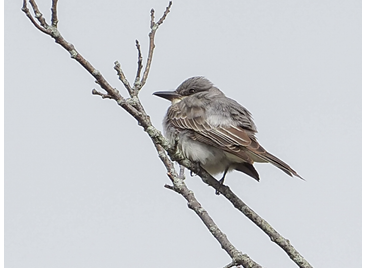
Maine’s second accepted Gray Kingbird was found October 12, 2020, at Brunswick. Photograph by Gordon Smith.
Gray Kingbird (Tyrannus dominicensis). A bird seen briefly was fortuitously photographed at Brunswick, Cumberland, October 12, 2020 (Gordon Smith†*; 2020-040), providing Maine’s second indisputable record.
Say’s Phoebe (Sayornis saya). Maine’s fifth accepted record—in addition to about a dozen unreviewed—was at New Gloucester, Cumberland, September 23–24, 2020 (Dave Fensore†; Charles Duncan†, Laura Blutstein†, Weston Barker†; 2020-035).
Cave Swallow (Petrochelidon fulva). The committee accepted a sight record from Pine Point, Scarborough, Cumberland, November 8, 2005 (Randy Harrison*; 2005-002) observed four days before Maine’s previously accepted—and photographed—first state record.
Northern Wheatear (Oenanthe oenanthe). Two different birds were found four days apart, one at Freeport, Cumberland, October 8–9, 2020 (Stephen Benenson†; Louis Bevier†*, Doug Hitchcox†; 2020-038) and one at Parsons Beach, Kennebunk, York, October 12, 2020 (Magill Weber†*; Luke Seitz†; 2020-039). NOT ACCEPTED, IDENTIFICATION QUESTIONED: One reported on Bald Mountain, Franklin, September 18, 2020 (2020-034) was tentatively identified after the fact. Failure to note the distinctive tail pattern and the casual nature of the description failed to gain support. These are the first reports the committee has considered for this species since it was added to the review list for reports from 2014 onward.
Sage Thrasher (Oreoscoptes montanus). The committee formally accepted Maine’s only Sage Thrasher, seen by many at Cape Neddick, York, November 17 to December 6, 2001 (Lincoln Maley†; Denny Abbott†, Jason Forbes†, Peter Vickery†; 2001-004) and originally reported in Ellison and Martin (2002).
Gray-crowned Rosy-Finch (Leucosticte tephrocotis). Although it had long been recognized as a valid record, this year the committee formally accepted Maine’s only report of the species, an adult that overwintered at a feeding station in Gorham, Cumberland, December 15, 1936, to March 10, 1937 (Mr. and Mrs. Verdell Waterman; Alfred Gross†*; 1936-001). The committee further agreed with Gross (1937) that the bird represented the Hepburn’s subspecies (L. t. littoralis).
Lesser Goldfinch (Spinus psaltria). After accepting two more recent reports, the committee formally accepted this earlier occurrence at Georgetown, Sagadahoc, December 15, 1992, to April 13, 1993 (Jean and Lew Frank; Denny Abbott†, Lysle Brinker†; 1992-002), which was at the time a first for New England (Nikula 1993; Maine Bird Notes volume 8, number 2, December 1993). All three Maine birds have been black-backed males.
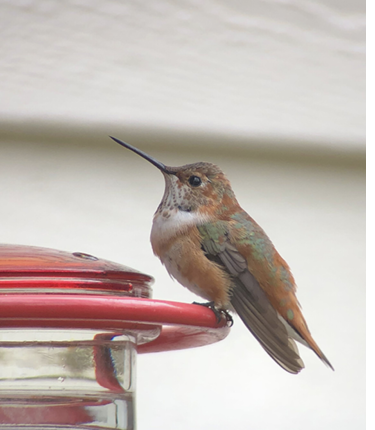
An immature male Rufous Hummingbird was at Yarmouth from October 18 to December 5, 2020. Photograph October 27, 2020, by Luke Seitz.
Cassin’s Sparrow (Peucaea cassinii). This is another species already on the state list provisionally, and the committee accepted Maine’s only report, a bird photographed on Mount Desert Rock, Hancock, September 16–25, 1986 (Harriet Corbett†; 1986-001) and first reported by James (1990).
Brewer’s Sparrow (Spizella breweri). Maine’s second was photographed at Petit Manan National Wildlife Refuge, Steuben, Washington, September 4, 2020 (Jada Fitch†; 2020-027).
LeConte’s Sparrow (Ammospiza leconteii). Maine’s third accepted record—with five others yet to be reviewed—was an immature at Pemaquid Point, Lincoln, October 12, 2020 (Zeke Smith†; 2020-041).
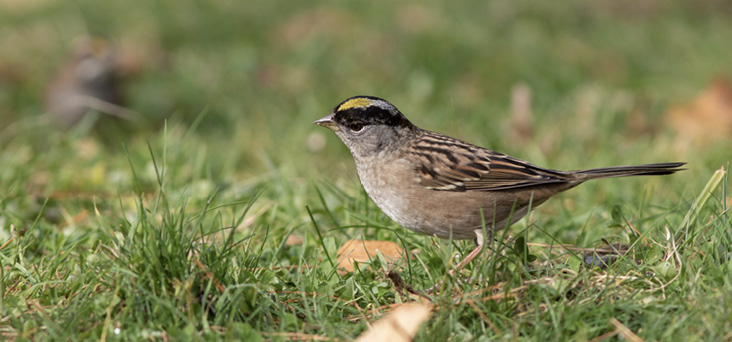
This Golden-crowned Sparrow was at Abbot October 19–22, 2020. Photograph October 19, 2020, by Doug Hitchcox.
Golden-crowned Sparrow (Zonotrichia atricapilla). The species has been provisionally on the state list based on earlier published reports from 1985 to 2000. The committee reviewed and accepted two adults found in 2020: one in Jefferson, Lincoln, May 11, 2020 (Thomas and Jean Shippee†; 2020-007) and one in Abbot, Piscataquis, October 19–22, 2020 (Ellen Blanchard†; 2020-042).
Harris’s Sparrow (Zonotrichia querula). A basic-plumaged adult frequented a feeding station in Levant, Penobscot, December 6, 2019, to March 31, 2020 (Carol Belanger†; 2019-053).
Henslow’s Sparrow (Centronyx henslowii). This is another species provisionally on the state list based on about a dozen reports, many published, from 1969 to 2005. Two sight records were accepted from Monhegan Island, Lincoln: one on May 20, 1983 (Peter Vickery*, Charles Duncan; 1983-001) and one on October 3, 2003 (Jeremiah Trimble*; 2003-004). NOT ACCEPTED, IDENTIFICATION QUESTIONED: Although no members actually questioned that skilled observers correctly identified a bird on Monhegan Island, Lincoln, October 3, 1997 (1997-002), the committee could not accept the record without any evidence, either photographic or written. A report of a singing bird in grasslands along Church Road, Sidney, Kennebec, August 10, 2005 (2005-010) did not eliminate other species.
Green-tailed Towhee (Pipilo chlorurus). The committee formally accepted one of only two reports for Maine, a bird that overwintered in Southwest Harbor, Hancock, November 15, 1988, to April 27, 1989 (M. L. Hughes; Peter Vickery*, unknown photographer†; 1988-002).
Bullock’s Oriole (Icterus bullockii). Amazingly, an immature male overwintered in the same neighborhood in Camden, Knox, December 31, 2019, to February 26, 2020 (Kristin Kalajian†; Doug Hitchcox†, Margaret Viens†; 2019-055) where another immature male overwintered in 2016–2017.
Shiny Cowbird (Molothrus bonariensis). The committee formally accepted Maine’s only Shiny Cowbird, a singing male on Monhegan Island, Lincoln, May 25–26, 1991 (Lysle Brinker, Jeff Wells; Scott Surner*, Carol Mardeusz†; 1991-001) that was originally reported by Surner (1992).
Golden-winged Warbler (Vermivora chrysoptera). A cooperative, phenotypically pure adult male was enjoyed by many at Capisic Pond Park, Portland, Cumberland, May 17, 2020 (Casey Cesari, Leah Pillsbury; Becky Marvil†, Brendan Thomas†, Don Thompson†; 2020-011).
Virginia’s Warbler (Leiothlypis virginiae). Maine’s fourth report—and third reviewed—all from Monhegan Island, Lincoln, was present May 29–30, 2014 (Gabriel Willow†; Luke Seitz†, Jeremiah Trimble†; 2014-007).
MacGillivray’s Warbler (Geothlypis tolmiei). Maine’s fifth—all since 2009—was on Monhegan Island, Lincoln, September 17, 2020 (Lukas Musher†*; 2020-032).
Black-throated Gray Warbler (Setophaga nigrescens). Maine’s second and third accepted records were from Mount Desert Rock, Hancock, August 31, 1987 (Harriet Corbett*; 1987-001) and Monhegan Island, Lincoln, May 29–30, 2020 (Don Reimer†; 2020-030). A description of the 1987 bird, which is the earliest report for Maine, was originally published in Maine Bird Notes volume 1, number 3, Autumn 1987.
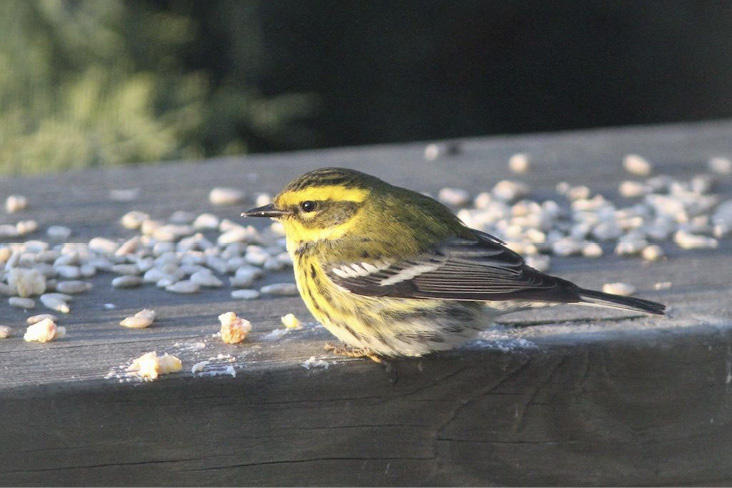
An immature male Townsend’s Warbler was at Winterport from November 28, 2012 to January 19, 2013. Photograph November 30, 2012, by Doug Hitchcox.
Townsend’s Warbler (Setophaga townsendi). Maine’s first accepted record was an immature male that frequented a feeding station in Winterport, Waldo, November 28, 2012, to January 19, 2013 (John Wyatt; Doug Hitchcox†, Margaret Viens†; 2012-026). Two previously published reports, both from 1993, remain to be reviewed.
Black-headed Grosbeak (Pheucticus melanocephalus). Two were found in Maine in 2020: a singing male at Mount Desert, Hancock, May 29–30, 2020 (Duane and Ruth Braun, Susan and Tom Hayward; Louis Bevier*†, Doug Hitchcox†, Becky Marvil†; 2020-014) and an immature male in St. George, Knox, September 29 to October 1, 2020 (Donald Frederick†; 2020-037). These are the third and fourth reports accepted by the committee. Up to twelve previously published reports remain unreviewed.
Lazuli Bunting (Passerina amoena). An immature bird on Monhegan Island, Lincoln, October 4–6, 1978 (Davis Finch; Tom Martin†; 1978-003) that was originally reported by Vickery (1979) is the second, and earliest, report accepted by the committee; an earlier sight report from 1974 has not been reviewed.
Acknowledgements
We thank Paula Work of the Maine State Museum for providing photographs of the Brooks Willow Ptarmigan specimen, and Scott Swann of College of the Atlantic for information about the Belfast Barn Owl specimen.
References
- Abbott, D. J., III and D. W. Finch. 1978. First Variegated Flycatcher (Empidonomus varius) record for the United States. American Birds 32(2):161–163.
- Applegate, R. D. 1996. Extralimital occurrences of Willow Ptarmigan, Lagopus lagopus, in Maine. Canadian Field-Naturalist 110(4):715.
- Bevier, L. 2017. Sixth Report of the Maine Bird Records Committee. Bird Observer 45(2):96–104.
- Clark, C. H. 1905. Additions to an eastern Maine collection. The Journal of the Maine Ornithological Society 7(1):23–24.
- Cramp, S. and K. E. L. Simmons, eds. 1977. The Birds of the Western Palearctic. Vol. 1: Ostrich to Ducks. Oxford: Oxford University Press.
- Ellison, W. G. and N. L. Martin. 1995. The Fall Season, August 1–November 1, 1994: New England Region. Field Notes 49(1):20–24.
- Ellison, W. G. and N. L. Martin. 2000. The Fall Migration, August–November, 1999: New England. North American Birds 54(1):26–30.
- Ellison, W. G. and N. L. Martin. 2002. The Fall Migration, August–November, 2001: New England. North American Birds 56(1):28–32.
- Ellison, W. G. and N. L. Martin. 2004. The Fall Migration, August–November, 2003: New England. North American Birds 58(1):36–41.
- Finch, D. W. 1975. The Spring Migration: Northeastern Maritime Region. American Birds 29(1):125–129.
- Griscom, L. 1937. European dunlins in North America. Auk 54(1):70–72.
- Griscom, L. and D. F. Snyder. 1955. The Birds of Massachusetts: An Annotated and Revised Check List. Salem, Massachusetts: Peabody Museum.
- Gross, A. O. 1937. Hepburn’s Rosy Finch in Maine. Auk 54(3):396–397 (photo between pp. 394–395).
- Iliff, M. J. and M. P. Garvey. 2010. Fourteenth Report of the Massachusetts Avian Records Committee. Bird Observer 38(2):82–101.
- James, D. J. 1990. A 1986 record of Cassin’s Sparrow from Maine, Mount Desert Rock, September 16–25, 1986. Bird Observer 18(6):329–330.
- Johnson, R. I. 2004. The rise and fall of the Boston Society of Natural History. Northeastern Naturalist 11(1):81–108.
- McEneaney, T. 2004. A Whooper Swan (Cygnus cygnus) at Yellowstone National Park, Wyoming, with comments on North American reports of the species. North American Birds 58(2):301–308.
- McGuire, H. L., S. S. Taylor, and F. H. Sheldon. 2019. Evaluating the taxonomic status of the Great White Heron (Ardea herodias occidentalis) using morphological, behavioral, and genetic evidence. The Auk: Ornithological Advances 136:1–18.
- Mitra, S. S. and Fritz, J. 2002. Two Great White Herons (Ardea (herodias) occidentalis) in New York, Sep-Nov 2001. Kingbird 52(1):27-34.
- Nikula, B. 1993. The winter season, December 1, 1992–February 28, 1993: New England region. American Birds 47(2):239–243.
- Palmer, R. S. 1949. Maine Birds. Bulletin of the Museum of Comparative Zoology 102:1–656.
- Palmer, R. S., ed. 1976. Handbook of North American Birds. Vol. 2: Waterfowl (Part 1). New Haven, Connecticut: Yale University Press.
- Perkins, S. 1997. The Spring Migration: New England Region. Field Notes 51(4):844–847.
- Sheehan, W. J. 2020. Whooper Swan. In Birds of Maine. P. D. Vickery, C. D. Duncan, J. V. Wells, and W. J. Sheehan. Memoirs of the Nuttall Ornithological Club, No. 25. Princeton, New Jersey: Princeton University Press. p. 100–101.
- Surner, S. 1992. First record of Shiny Cowbird (Molothrus bonariensis) in Maine. Maine Bird Notes 5(1):1–2.
- Swain, J. M. 1904. Editorial Chat. The Journal of the Maine Ornithological Society 6(1):1–3.
- Vickery, P. D. 1979. The Autumn Migration, August 1–November 30, 1978: Northeastern Maritime Region. American Birds 33(2):154–158.
- Vickery, P. D. 1980. The Spring Migration, March 1–May 31, 1980: Northeastern Maritime Region. American Birds 34(5): 754–757.
- Vickery, P. D. 2020. Bar-tailed Godwit. In Birds of Maine. P. D. Vickery, C. D. Duncan, J. V. Wells, and W. J. Sheehan. Memoirs of the Nuttall Ornithological Club, No. 25. Princeton, New Jersey: Princeton University Press. p. 201.
